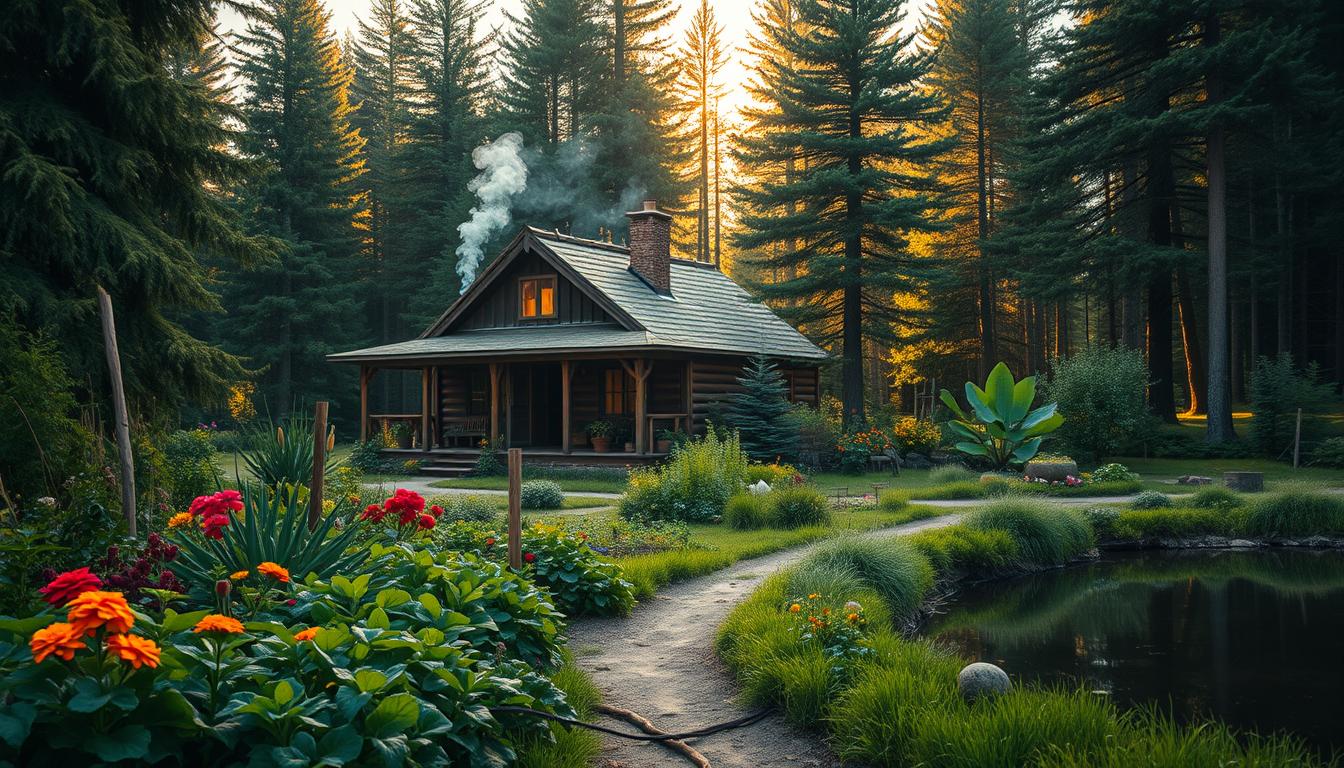Over the past two years, many people have embraced a simpler, more self-reliant lifestyle. This shift has led to a significant rise in homesteading, a practice that focuses on food sovereignty and partial self-sufficiency. Whether you live in the countryside or a bustling city, homesteading can be tailored to fit your space and needs.
Urban agriculture has grown by 78% since 2020, showing that even small spaces can support this way of life. For example, one family produces 65% of their food on just a quarter-acre suburban lot. The pandemic played a role in this trend, accelerating interest by 142% as people sought more control over their food sources.
Starting small is key. You don’t need vast land to begin. Simple steps like growing herbs on a windowsill or raising backyard chickens can set you on the path to self-reliance. Homesteading is about progress, not perfection.
Key Takeaways
- Homesteading has surged in popularity, especially in urban areas.
- It’s customizable, from small-scale gardening to full off-grid living.
- Many families are achieving significant food self-sufficiency.
- The pandemic accelerated interest in this lifestyle.
- Starting small is a practical and effective approach.
What is Homesteading?
Homesteading has deep roots in American history, dating back to the 1862 Homestead Act. This law granted 160-acre parcels to settlers willing to cultivate the land. Today, homesteading has evolved into a versatile way of life, blending traditional practices with modern sustainability.
Modern homesteading focuses on three key areas: food production, energy independence, and skill development. Studies show that 43% of homesteaders prioritize growing their own food, while 22% aim for energy independence through renewable sources like solar panels. The remaining 35% focus on learning skills like food preservation and community bartering.
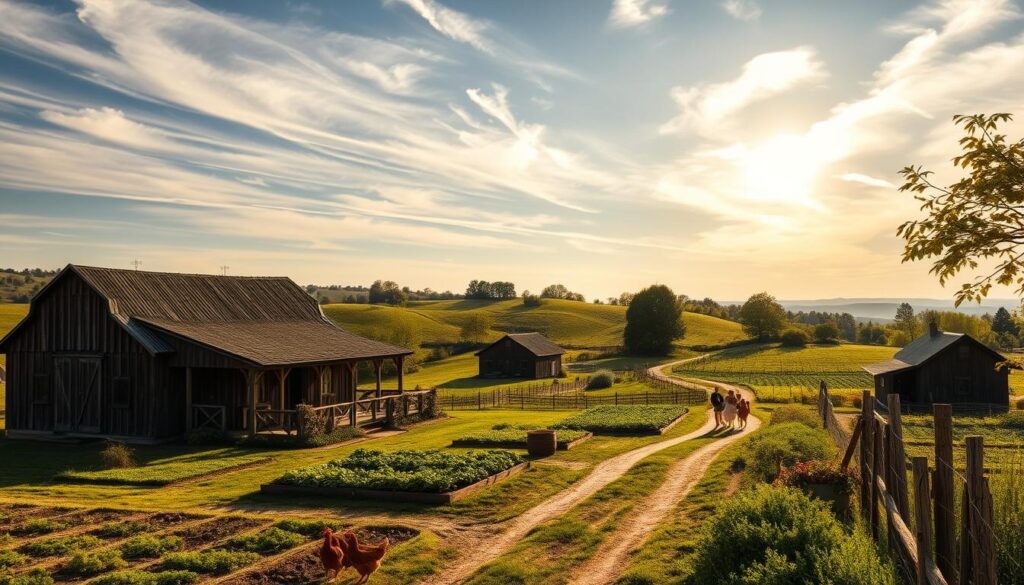
Contrary to popular belief, 68% of homesteaders maintain regular jobs. This debunks the myth that homesteading requires a full-time commitment. Instead, it’s a flexible lifestyle that can be adapted to fit your home and schedule.
Homesteading exists on a continuum. It can range from a small balcony garden in the city to a sprawling ranch in the countryside. According to USDA statistics, 18% of urban households now grow some of their own food, proving that space is no barrier to this way of life.
Over the years, homesteading has transformed from a necessity to a choice. It’s about reclaiming control over your resources and fostering a deeper connection to the land. Whether you’re starting with a few herbs or a full-scale farm, homesteading is a journey worth exploring.
Why Start New Homesteading?
Food security has become a top priority for households across the country. With 92% of new homesteaders citing concerns about access to fresh, healthy food, this way of living offers a practical solution. Families are finding that producing their own food not only ensures safety but also saves money. On average, a family can save $1,200 annually through food preservation techniques.
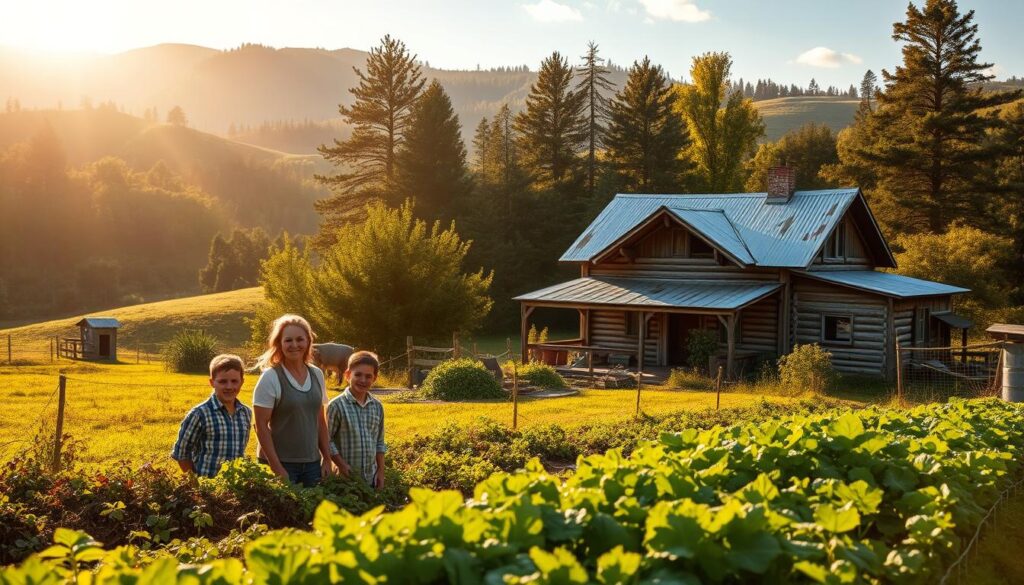
- Safety (31%): Ensuring a reliable food source.
- Sustainability (27%): Reducing reliance on industrial systems.
- Savings (19%): Cutting grocery bills significantly.
- Health (15%): Access to organic, nutrient-rich produce.
- Heritage (8%): Passing down traditional skills to future generations.
Take the case of a Phoenix family that eliminated 83% of their grocery bills by growing and preserving their own food. Their story highlights the financial and practical benefits of this lifestyle. Beyond savings, 67% of homesteaders report reduced stress levels, citing the therapeutic benefits of working with the land.
Homesteading also has a positive environmental impact. A typical homestead reduces its carbon footprint by 4.2 tons annually. This makes it a sustainable choice for those looking to live more responsibly. Additionally, 94% of children raised on homesteads develop advanced life skills, from gardening to problem-solving, giving them a unique edge in today’s world.
Assessing Your Readiness for Homesteading
Before diving into homesteading, it’s crucial to assess your readiness. This lifestyle requires dedication, skills, and a clear understanding of the work involved. Taking the time to evaluate your preparedness can save you from common problems down the road.

Evaluating Your Skills and Resources
Start by conducting a skills audit. Rate yourself on essential competencies like gardening, animal care, and food preservation. Many beginners underestimate the time and effort required, leading to challenges later. A resource calculator can help you determine if you have the minimum 14 hours per week needed for a basic setup.
Don’t forget to account for unexpected costs. For example, 63% of homesteaders underestimate animal care expenses by 300%. Shadowing experienced homesteaders through programs like WWOOF can provide valuable insights and practical knowledge.
Understanding the Commitment
Homesteading is a rewarding but demanding lifestyle. Studies show that 58% of failed attempts are due to unrealistic time commitments. Urban homesteaders face additional challenges, with 41% quitting within 18 months. Be honest about your ability to balance this lifestyle with other responsibilities.
Here are some key points to consider:
- Conduct a skills audit to identify areas for improvement.
- Plan for at least 14 hours per week for basic tasks.
- Account for unexpected costs, especially in animal care.
- Shadow experienced homesteaders to gain practical knowledge.
- Be realistic about your time and energy commitments.
By taking these steps, you’ll set yourself up for a successful and sustainable homesteading journey.
Creating Your Homesteading Vision
Crafting a clear vision is the foundation of a successful homesteading journey. A well-defined plan ensures your efforts align with your goals and needs. Whether you’re starting small or aiming for full self-sufficiency, a phased approach helps turn your dreams into reality.
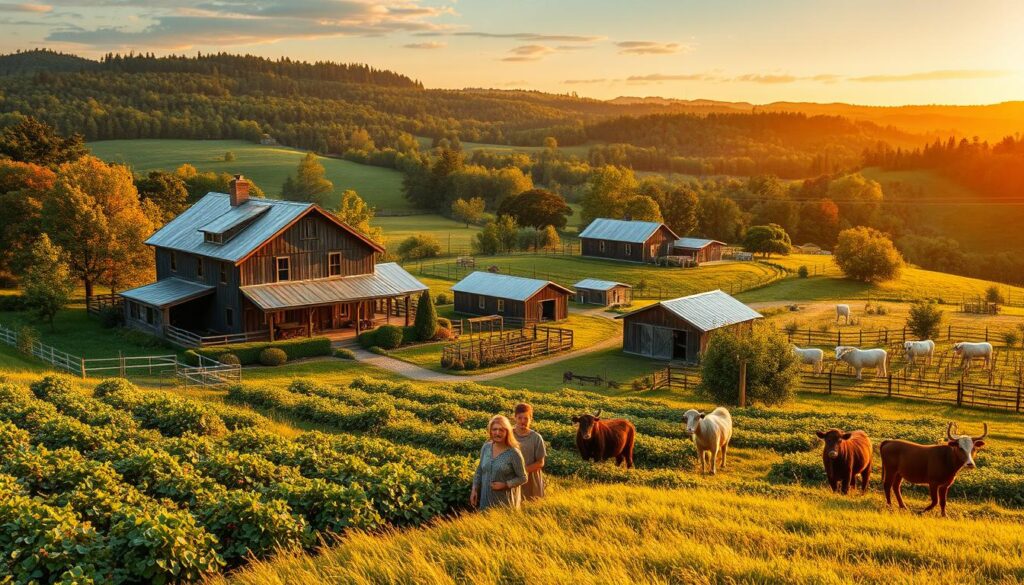
Successful homesteaders often implement their vision over 3-5 years. For example, a 4-stage wheat independence plan starts with soil preparation, followed by planting, harvesting, and finally, processing. This structured approach ensures steady progress and minimizes overwhelm.
Begin by blending practical needs with aspirational goals. A vision board workshop can help you visualize your ideal homestead. Include elements like food production, energy sources, and skill development to create a comprehensive roadmap.
When selecting land, a zoning law checklist is essential. Ask 23 critical questions to ensure the property meets your requirements. For instance, verify water access, building restrictions, and agricultural allowances to avoid costly mistakes.
Energy independence is another key consideration. Compare solar, wind, and biogas options using an energy matrix. Here’s a quick comparison of their ROI timelines:
| Energy Source | Initial Cost | ROI Timeline |
|---|---|---|
| Solar | $10,000 | 5-7 years |
| Wind | $15,000 | 8-10 years |
| Biogas | $7,000 | 3-5 years |
Take inspiration from an urban couple who transitioned to a rural homestead in five years. They started with a small garden, expanded to raising chickens, and eventually installed solar panels. Their story shows how persistence and planning lead to success.
Digital tools like the Homestead Project Planner app can streamline your efforts. This app helps you track progress, set milestones, and manage resources efficiently. With the right tools and a clear vision, your homesteading journey can thrive.
Financial Planning for New Homesteading
Managing finances is a critical step in building a sustainable homestead. Without a clear plan, unexpected costs can derail your efforts. Whether you’re starting small or aiming for full self-sufficiency, smart money management ensures your journey stays on track.
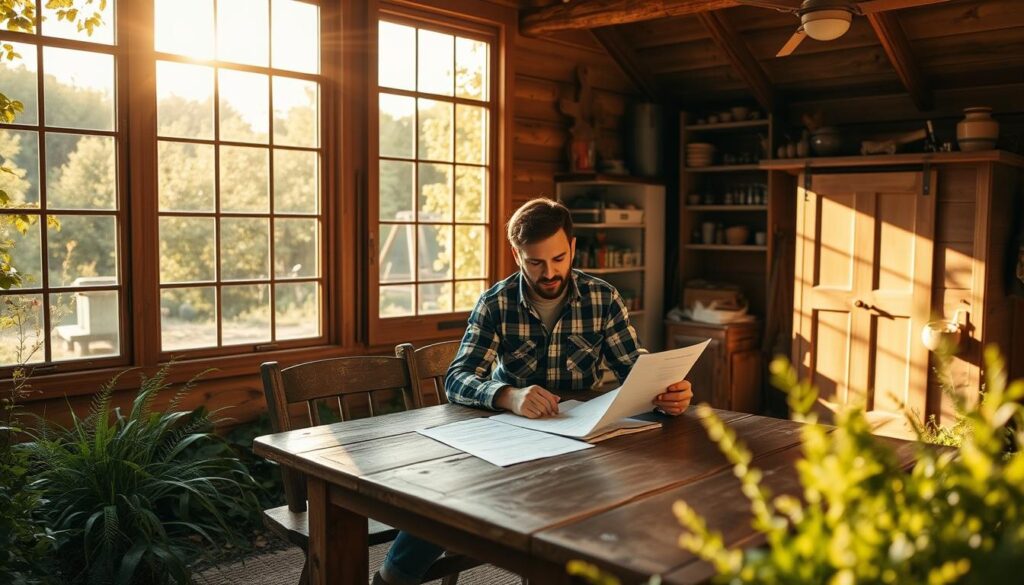
Paying Off Debt
Before diving into homesteading, it’s wise to address any existing debt. The debt snowball method has a 78% success rate, making it a popular choice. This approach focuses on paying off smaller debts first, creating momentum for tackling larger ones. On average, homesteaders can clear their debt in 14 months using this strategy.
Consider funding your homestead activities through farm stands or direct-marketing. For example, broiler chickens yield a 137% return when sold directly to consumers. This not only helps pay off debt but also generates extra money for future investments.
Creating a Budget
A detailed budget is essential for managing your homestead’s finances. Start with a worksheet that includes 27 line items specific to startup costs. This helps you track expenses and avoid overspending. Common items include seeds, tools, and animal care supplies.
Don’t forget to explore funding sources like USDA grants and agricultural loans. These can significantly reduce your initial costs. Additionally, using expense-tracking apps designed for small-scale producers can simplify your financial management.
Here are some tips to keep your budget on track:
- Prioritize essential purchases over luxury items.
- Set aside a portion of your income for unexpected expenses.
- Regularly review and adjust your budget as your homestead grows.
By taking these steps, you’ll ensure your homestead thrives without straining your finances. For more tips on managing your money, visit NewGen Living.
Choosing the Right Property
Finding the perfect property is a crucial step in building a sustainable lifestyle. The land you choose will determine your success in achieving self-sufficiency. Start by evaluating critical factors like sun exposure patterns, well output tests, and flood zone history. These elements ensure your property meets your needs.
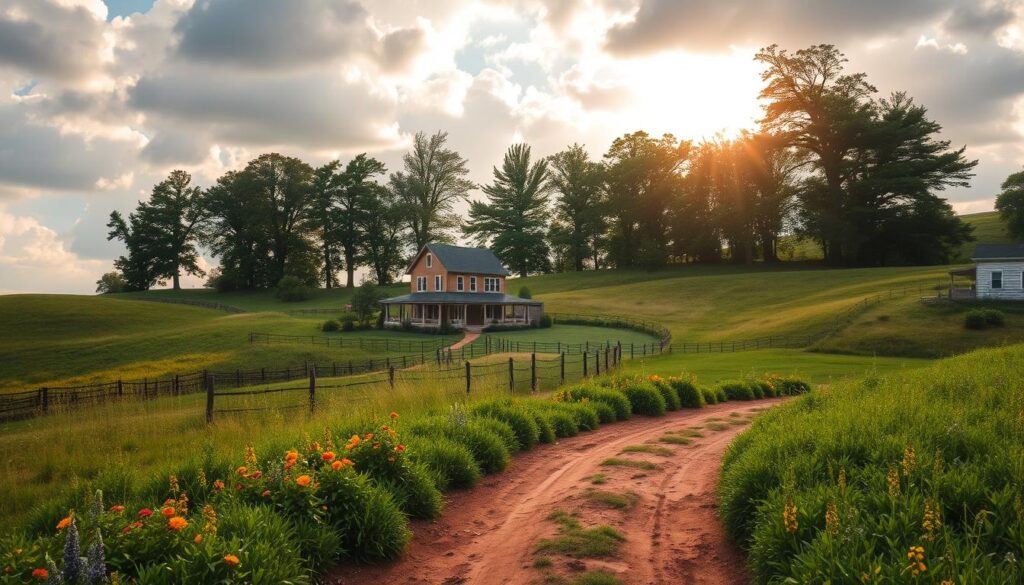
Assessing Land and Water Resources
When evaluating land, use an 18-point inspection checklist. This matrix covers soil quality, slope, and accessibility. Pay special attention to water resources. Conduct well output tests or consider rainwater catchment systems. Each option has its pros and cons, so weigh them carefully.
Water rights vary by state. In riparian states, landowners have rights to adjacent water sources. In prior appropriation states, water use is regulated by permits. Understanding these laws ensures you have access to the resources you need.
Understanding Zoning Laws
Zoning laws dictate how you can use your property. Agricultural zoning allows for farming and livestock, while residential zoning may have restrictions. Use a zoning decoder to identify classifications in your areas of interest. This step prevents costly mistakes and ensures compliance.
Hidden costs can surprise even the most prepared homesteaders. For example, 29% of properties require $15,000 or more in soil amendments. Factor these expenses into your budget to avoid financial strain.
Here’s a quick comparison of water systems:
| System | Initial Cost | Maintenance |
|---|---|---|
| Well | $5,000-$10,000 | Low |
| Rainwater Catchment | $2,000-$5,000 | Moderate |
By carefully assessing your land and understanding local laws, you’ll set the stage for a thriving homestead. Take your time, ask questions, and make informed decisions.
Starting Small: Homesteading in Limited Spaces
Limited space doesn’t have to limit your homesteading dreams. With creativity and planning, even the smallest areas can become productive and fulfilling. Whether you’re in an apartment or a tiny backyard, there’s a way to make it work.
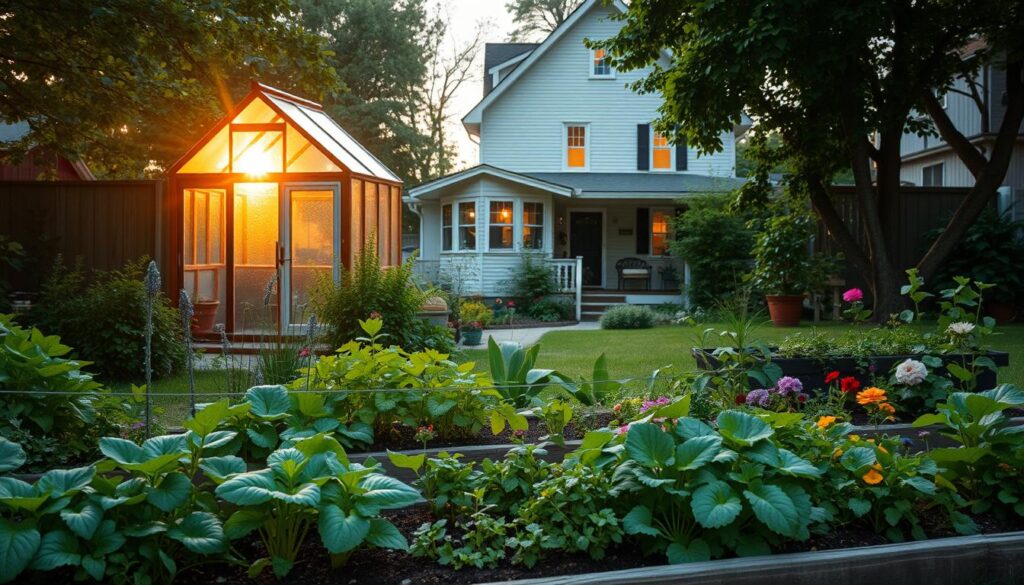
Vertical gardens are a game-changer for urban homesteaders. In fact, 93% of apartment dwellers use them to maximize their space. A windowsill herb garden can yield an average of 1.4 pounds of fresh herbs each month. That’s enough to enhance your cooking and reduce grocery trips.
Here are some practical ideas to get started:
- Space Hacks: Design a 14-square-foot balcony chicken coop for fresh eggs.
- Container Gardening: Grow high-yield crops like tomatoes and peppers in pots.
- Indoor Mushrooms: Set up a simple 3-step mushroom cultivation system.
- Micro-Livestock: Consider quail, rabbits, or guinea pigs for small-scale animal husbandry.
- Community Gardens: Negotiate a lease for a plot in a local garden.
Micro-livestock is another great option for small spaces. Here’s a quick comparison of popular choices:
| Animal | Space Needed | Yield |
|---|---|---|
| Quail | 2 sq ft | Eggs |
| Rabbits | 4 sq ft | Meat |
| Guinea Pigs | 3 sq ft | Meat |
Homesteading in small spaces is about making the most of what you have. It’s a way to bring nature into your home and enjoy the benefits of self-sufficiency. Start small, stay consistent, and watch your efforts grow.
Essential Tools and Equipment for Homesteading
Equipping your space with the right tools can make all the difference in your journey. Whether you’re cooking, gardening, or raising animals, having the proper gear ensures efficiency and success. Let’s explore the must-have items for each area of your work.
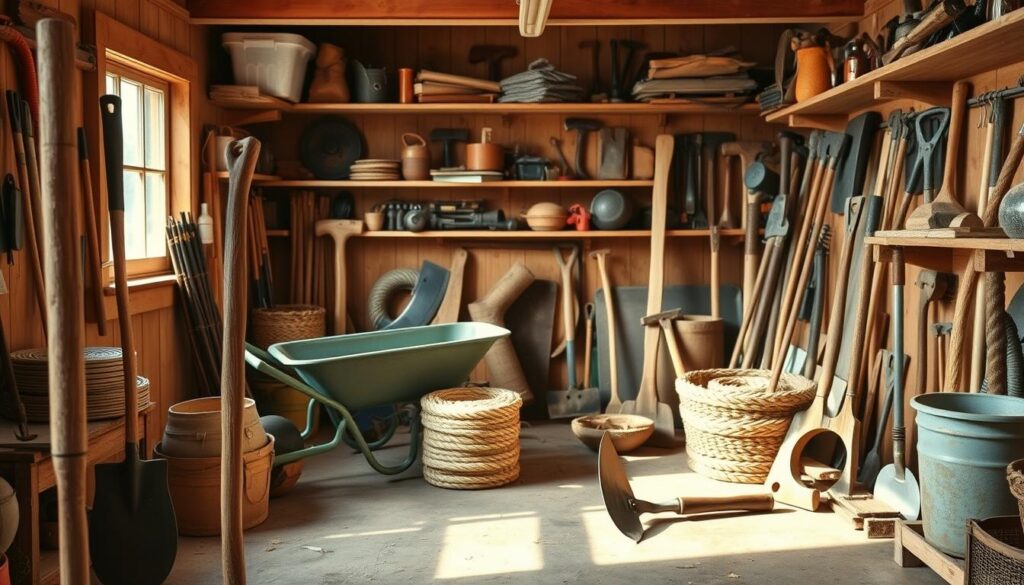
Kitchen Essentials
Your kitchen is the heart of your home, and the right products can simplify meal prep and preservation. A stainless steel canner ($49.99) is perfect for preserving fruits and vegetables, while a pressure cooker speeds up cooking times. For durability, consider a Lehman’s Lodge Skillet ($18.99), which lasts for years with proper care.
Another standout is the heat-powered stove fan ($129), which circulates warmth efficiently. If you’re starting from scratch, prioritize versatile items like cast iron cookware. They’re easy to maintain and perfect for everything from frying to baking.
Gardening Tools
Gardening requires reliable tools to make the most of your efforts. A broadfork ($139) is ideal for aerating soil without disrupting its structure. For smaller tasks, hand tools like trowels and pruners are essential. When choosing tools, opt for galvanized steel for longevity and rust resistance.
Don’t forget about water filtration. A Berkey water filter ensures clean drinking water, a critical resource for any homestead. Pair it with a rainwater catchment system for a sustainable solution.
Livestock Equipment
Raising animals demands specialized gear. Repurposed livestock feeders are a budget-friendly option, while hog scalders and chicken pluckers streamline processing. For smaller spaces, consider micro-livestock like quail or rabbits, which require minimal equipment.
Investing in quality products upfront saves time and effort in the long run. For more tips on building a sustainable lifestyle, visit NewGen Living.
Gardening for Beginners
Gardening is a rewarding way to connect with nature and provide for your family. Whether you’re growing herbs on a windowsill or planting a backyard vegetable patch, starting a garden can be simple with the right approach. The key is to focus on the basics: choosing the right plants and preparing your soil properly.
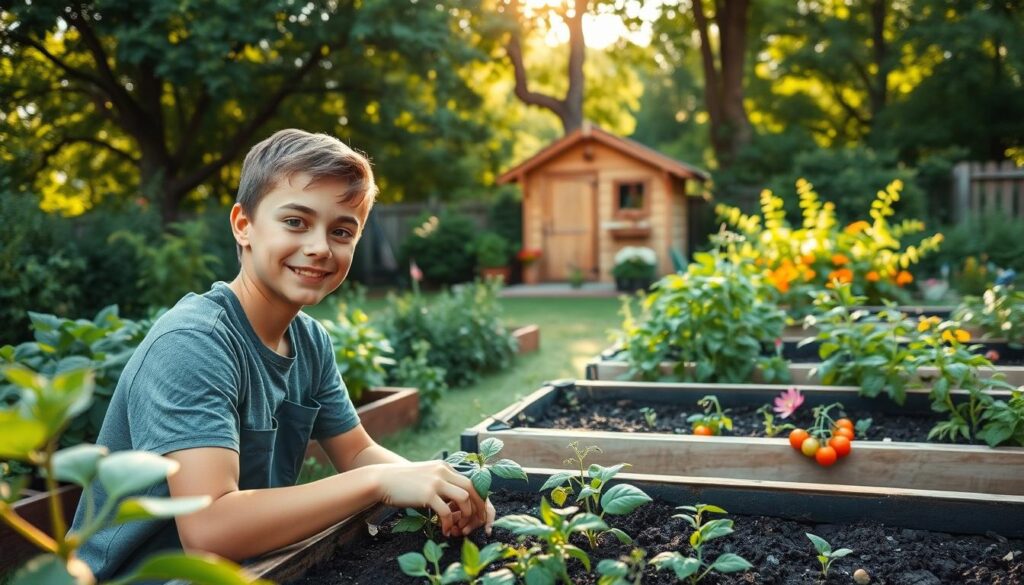
Choosing What to Grow
Selecting the right crops is crucial for a successful garden. Studies show that 87% of failed gardens cite poor crop selection. Beginners should start with easy-to-grow plants that yield high returns. Here are 12 beginner-friendly options:
- Tomatoes: Versatile and high-yielding.
- Lettuce: Grows quickly and requires minimal space.
- Green Beans: Perfect for vertical gardening.
- Radishes: Ready to harvest in just 30 days.
- Herbs: Great for small spaces and culinary use.
Companion planting can also boost your garden’s productivity. For example, planting basil near tomatoes improves flavor and deters pests. A companion planting chart with 35 proven combinations can guide your choices.
Soil Preparation and Planting
Healthy soil is the foundation of a thriving garden. Start by testing your soil to understand its nutrient levels. Soil testing saves an average of $420 per year in amendments by pinpointing exactly what your garden needs. Here’s a quick guide to interpreting N-P-K ratios:
| Nutrient | Role | Optimal Level |
|---|---|---|
| Nitrogen (N) | Promotes leaf growth | 2-4% |
| Phosphorus (P) | Supports root development | 1-2% |
| Potassium (K) | Enhances overall health | 2-3% |
Once your soil is ready, consider season extension techniques like cold frames. These simple structures protect plants from frost, allowing you to grow longer into the fall. For those interested in sustainability, seed saving is another valuable skill. Learn the differences between heirloom and hybrid seeds to preserve your favorite varieties year after year.
Gardening is about more than just growing things—it’s a journey of learning and discovery. With the right products and techniques, you’ll enjoy fresh, homegrown produce and the satisfaction of self-sufficiency.
Raising Livestock on Your Homestead
Raising animals on your property can bring both practical benefits and a deeper connection to your land. Whether you’re raising chickens for eggs or larger animals for meat and dairy, livestock can enhance your self-sufficiency. It’s a rewarding way to provide for your family while learning valuable skills.
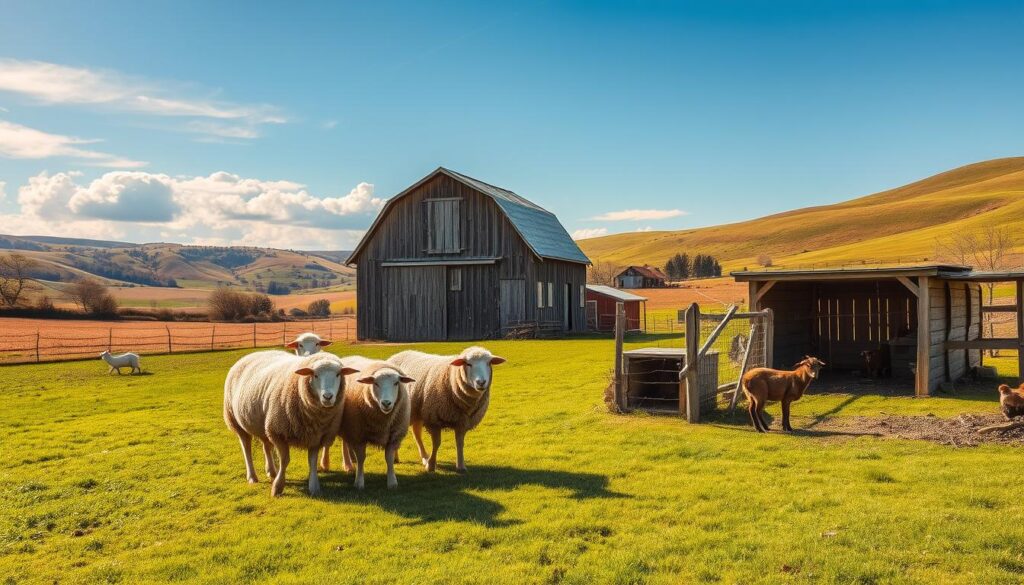
Starting with Chickens
Chickens are a popular choice for beginners. They’re relatively easy to care for and provide fresh eggs daily. Meat chickens, for example, are ready for processing in just 8-12 weeks. This makes them a quick and efficient source of protein.
When planning your flock, consider your egg needs. A flock size calculator can help you determine how many chickens to raise. Pasture rotation is another key factor. A 7-day system on half an acre ensures your birds have access to fresh grass and reduces feed costs.
Butchering logistics are also important. You can choose between mobile processing units or DIY methods. Each option has its pros and cons, so weigh them based on your resources and comfort level.
Considering Larger Animals
If you’re ready to expand, larger animals like cows or goats can provide milk, meat, and even companionship. However, they require more space and resources. For instance, the startup cost for a dairy cow averages $3,200.
Veterinary care is another consideration. Compare costs for bovine (cows) and caprine (goats) care to budget effectively. Manure management is also crucial. A composting system can turn waste into valuable fertilizer for your garden.
Here’s a quick comparison of popular livestock options:
| Animal | Yield | Startup Cost |
|---|---|---|
| Chickens | Eggs, Meat | $100-$300 |
| Goats | Milk, Meat | $1,500-$2,000 |
| Cows | Milk, Meat | $3,000-$3,500 |
Adding animals to your homestead is a big step, but it’s worth the effort. With proper planning and care, you’ll enjoy the benefits of fresh food and a closer connection to your land.
Preserving Food for Year-Round Use
Preserving food is a time-tested way to ensure your family has fresh, nutritious options year-round. Whether you’re canning, freezing, drying, or fermenting, these methods help you make the most of your harvest. Proper preservation reduces waste and ensures you have access to healthy food even in the off-season.
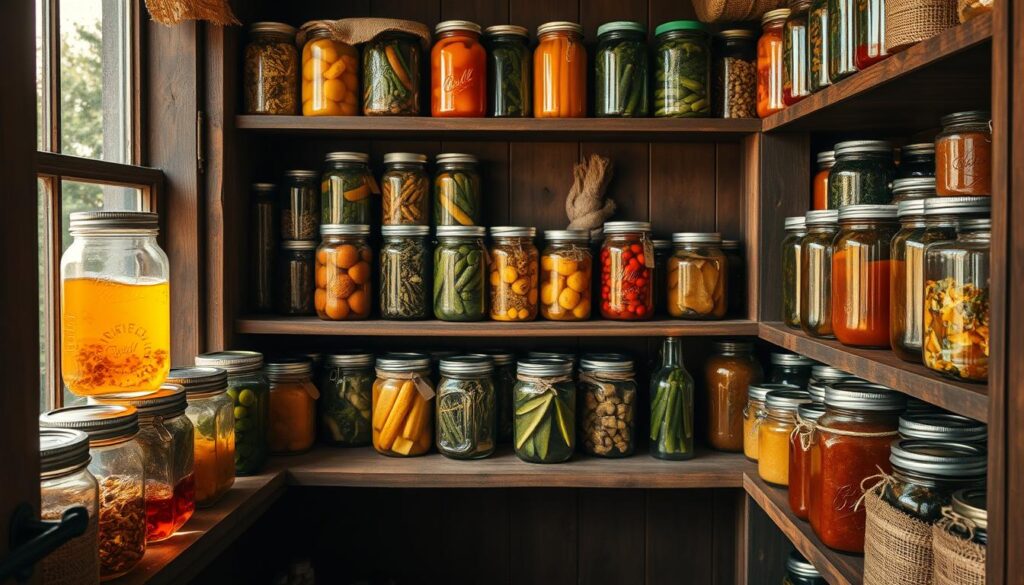
Canning and Freezing
Canning is a reliable method for long-term storage. Using a pressure canner reduces spoilage risk by 94%, making it a safe choice for preserving vegetables, fruits, and meats. Freezing, on the other hand, is quick and easy. It’s ideal for berries, greens, and pre-cooked meals. Here’s a cost comparison of preservation methods:
- Freezer: High upfront cost but low maintenance.
- Root Cellar: Affordable but requires space and temperature control.
- Canning: Moderate cost with long-term benefits.
Safety is crucial when canning. Follow a botulism prevention checklist to avoid contamination. Always use sterilized jars and lids for the best results.
Drying and Fermenting
Drying is one of the oldest preservation techniques. It’s perfect for herbs, fruits, and jerky. Dehydrators range from $80 to $300, depending on features. Fermentation, meanwhile, not only preserves food but also boosts nutrient bioavailability by 37%. Here are five essential vessels for your fermentation station:
- Glass jars with airlocks.
- Ceramic crocks.
- Stainless steel containers.
- Fermentation weights.
- Wooden tampers.
To stay organized, implement a pantry inventory system. Use a first-expired-first-out rotation to ensure nothing goes to waste. With these methods, you’ll enjoy fresh, home-preserved products all year long.
Building a Sustainable Homestead
Creating a sustainable homestead requires thoughtful planning and resource management. It’s about balancing energy, waste, and resources to create a life that’s both self-sufficient and environmentally friendly. Whether you’re just starting or looking to improve your current setup, sustainability is key to long-term success.
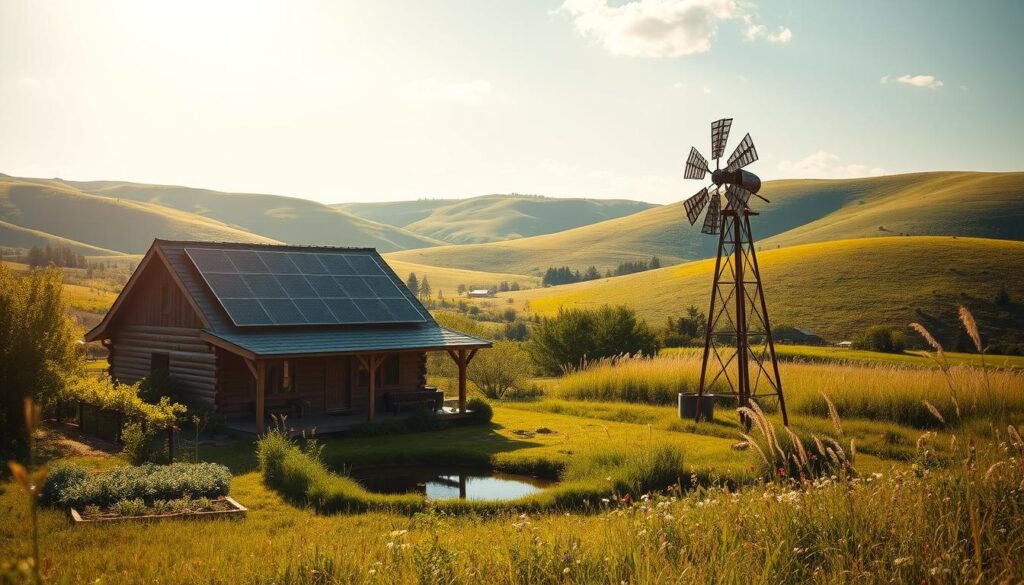
Using Renewable Energy
Renewable energy is a cornerstone of a sustainable homestead. Solar panels, wind turbines, and biogas systems can reduce your reliance on traditional power sources. For example, solar panels have an average ROI of 6.8 years, making them a smart investment for your land.
Here’s a quick comparison of renewable energy options:
| Energy Source | Initial Cost | ROI Timeline |
|---|---|---|
| Solar | $10,000 | 6.8 years |
| Wind | $15,000 | 8-10 years |
| Biogas | $7,000 | 3-5 years |
Conducting an energy audit is a great first step. Use a 15-point efficiency checklist to identify areas for improvement. This ensures your energy systems are optimized for maximum savings and sustainability.
Implementing Zero-Waste Practices
Zero-waste practices are essential for a sustainable life. Start by analyzing your waste stream. Studies show that 89% of waste can be reduced with proper strategies. Composting, recycling, and reusing products are simple yet effective ways to minimize your environmental impact.
Greywater irrigation is another powerful tool. It recycles household water for garden use, reducing waste and conserving resources. Check your state’s regulations to ensure compliance with local laws.
Here are some tips to get started:
- Set up a composting system for organic waste.
- Repurpose old items instead of throwing them away.
- Join a barter network to exchange goods and services.
By adopting these practices, you’ll create a circular economy that benefits both your homestead and the environment. Sustainability is a journey, and every small step counts.
Overcoming Challenges in New Homesteading
Homesteading comes with its fair share of challenges, but with the right strategies, you can overcome them. From predators to unpredictable weather, being prepared is key to success. For example, 62% of homesteaders face predator issues, but emergency protocols can reduce livestock losses by 78%.

One of the most common problems is managing crises. A 24-hour animal trauma kit is essential for treating injuries quickly. This kit should include bandages, antiseptics, and tools for minor surgeries. Having it ready saves time and ensures your animals receive immediate care.
Weatherproofing your homestead is another critical step. Prepare for frost, fire, and floods by reinforcing structures and creating evacuation plans. Simple things like insulating water pipes and clearing dry brush can prevent major disasters.
Pest control is also a significant challenge. Integrated management strategies, such as companion planting and natural predators, keep pests at bay without harmful chemicals. This way, you protect your crops while maintaining a healthy ecosystem.
Burnout is a real risk in homesteading. Balancing your workload is crucial. A 4-phase system helps you prioritize tasks and avoid exhaustion. Start with urgent chores, then move to maintenance, planning, and finally, personal time.
Lastly, don’t underestimate the power of community. Barn raising traditions and local support networks provide safety nets during tough times. Sharing knowledge and resources makes homesteading easier and more enjoyable.
Connecting with the Homesteading Community
Building connections with others who share your passion can transform your homesteading experience. Studies show that 74% of successful homesteaders participate in skill shares. Platforms like WWOOF connect 15,000 hosts globally, creating opportunities for learning and collaboration.
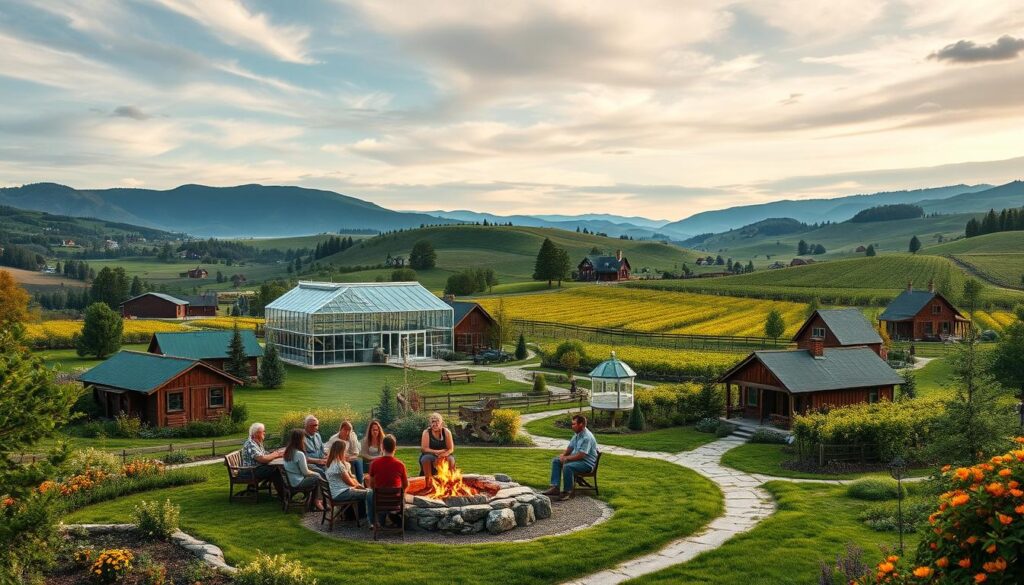
Joining national organizations is a great way to expand your network. Here’s a list of 28 groups that offer resources and support:
- American Homesteading Foundation
- National Sustainable Agriculture Coalition
- Backyard Homesteaders Association
Bartering is another cornerstone of the homesteading community. Value equivalency charts help people trade goods and services fairly. For example, a dozen eggs might be exchanged for a pound of honey or an hour of labor.
Social networks like Farmish provide a platform for homesteaders to share tips and connect. Key events, such as the Mother Earth News Fair, offer hands-on workshops and networking opportunities. These gatherings are perfect for learning new skills and meeting like-minded individuals.
Mentorship programs are invaluable for beginners. Six-month immersion opportunities allow you to learn directly from experienced people. This hands-on approach accelerates your growth and helps you avoid common pitfalls.
Here’s a quick comparison of community resources:
| Resource | Benefit |
|---|---|
| Skill Shares | Learn new techniques |
| Barter Networks | Exchange goods and services |
| Social Apps | Connect with others |
By engaging with the homesteading community, you’ll find support, inspiration, and practical solutions for your work. Whether you’re in rural or urban areas, these connections can make your journey more fulfilling and successful.
Conclusion
Starting your homesteading journey today is a step toward a more fulfilling and self-reliant life. On average, it takes 4.3 years to transition fully, but the rewards are worth it. Studies show that 89% of homesteaders report increased life satisfaction, proving this lifestyle brings joy and purpose.
Track your progress by celebrating milestones along the way. Whether it’s your first harvest or installing solar panels, each achievement is a step closer to your goals. Plan for the future by fostering multi-generational stewardship, ensuring your family benefits for years to come.
Continuous learning is key. Explore certification paths in sustainable practices or animal care to enhance your skills. Adapt to challenges like climate change by implementing resilient strategies, such as water conservation and crop rotation.
Ready to begin? Start small by planting a garden, raising chickens, or learning food preservation. Your land is your canvas—take the first step and watch your homestead grow.

